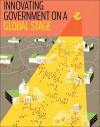SPONSORED SUPPLEMENT TO SSIR
Innovating Government on a Global Stage

This special supplement includes nine articles produced for the Open Government Partnership. OGP is a new effort to foster greater transparency and accountability, improve governance, and increase civic engagement worldwide.
-
Transforming Multilateralism: Innovation on a Global Stage
-
Shattering Decades of Diplomatic Protocol
-
Innovating Modern Democracy, in Brazil and Globally
-
Advocacy from the Inside: The Role of Civil Society
-
The UK’s Transparency Agenda
-
Tanzania’s Transparency Agenda
-
Philanthropy Can Catalyze an Open Government Movement
-
India in Open Government and Open Government in India
-
Building a Global Norm on Open Government
The Open Government Partnership (OGP) is a partnership in two respects. First, it is a partnership between governments that have committed themselves to practice and to promote the transparency of government operations. Second, it is a partnership between substantial components of global civil society, to collaborate with governments that are willing to bring about the enhanced transparency of government operations.
Such a partnership is not entirely without precedent. At least two worldwide institutions that were established about a decade earlier, the Global Fund to Fight AIDS, Tuberculosis, and Malaria and the Extractive Industries Transparency Initiative pioneered bringing together governments and civil society in pursuit of shared goals. Most observers of these institutions would agree that their effectiveness is in substantial measure a consequence of these collaborations.
OGP builds on the examples of these predecessors and more explicitly asserts that its mission can best be advanced through the ongoing interaction of governments and civil society. It seems fitting that such a collaboration should be constructed around the question of open government. In the past two decades, issues relating to governmental transparency have risen to the top of the agenda of civil society in all parts of the world. A number of new civil society institutions operating globally—among them Transparency International, Global Witness, and the International Budget Partnership—were established in the 1990s to campaign in different ways for enhanced transparency and against corruption. They were followed in the first decade of this century by the formation of a host of additional civil society institutions that have identified and focused on particular aspects of government transparency. The rapidly growing identification of civil society with the cause of open government during this period has been backed by a significant number of leading philanthropic institutions, which have recognized that transparency is the key to advances in other areas of concern. The philanthropies also have become important constituents for the engagement of civil society in OGP.
The great majority of the approximately 90 countries that now have freedom of information laws have adopted them since 1990.... Open government has become a global movement.
In the same era, generally in response to strong pressure from civil society, a large number of governments have adopted new laws to further government transparency. The great majority of the approximately 90 countries that now have freedom of information laws, for example, have adopted them since 1990. Although the movement for open government had its roots much earlier, it acquired the characteristics of a global movement in the 1990s—in much the way that other global movements, such as the women’s movement, the environmental movement, and the international human rights movement, developed two decades earlier. Just as those earlier movements have taken hold in all parts of the world except in a handful of the most repressive countries, the same is now true of the open government movement. In the short space of about two decades, it has become a global movement. The establishment of OGP shows how far it has come.
Of course, each of those earlier global movements has suffered significant setbacks from time to time, even as they continue to try to make progress in achieving their goals. No doubt the same will be true of OGP. Even governments that join OGP are likely to resist some proposals for heightened transparency, citing other governmental interests that may be compromised. In some cases, working out how far it is appropriate to go in the direction of transparency, while safeguarding national security, law enforcement confidentiality, trade secrecy, and individual privacy, will raise difficult issues. Some variation in the way that such questions are resolved at various times and places may be appropriate because of differing circumstances.
Yet the establishment of OGP suggests the emergence of a new norm for governance. It presumes that government operations should take place transparently and should be vigorously promoted both by the governmental members of OGP and by their civil society collaborators. That presumption can be achieved, but only if deviations from transparency are individually justified. That norm is the reverse of what had previously been the prevailing global practice. Although concealment was not often specifically articulated, in much of the world, government operations were previously expected to be hidden from view. The burden rested on the proponents of transparency to demonstrate that government operations should be visible. OGP represents the shift of that burden.
One of the early champions of transparent government in the United States, Supreme Court Justice Louis D. Brandeis, once wrote, “Sunlight is the best disinfectant.” Today, Justice Brandeis’s words could be a slogan that epitomizes the emerging norm of open government and its embrace by a global partnership of governments and of civil society.
Support SSIR’s coverage of cross-sector solutions to global challenges.
Help us further the reach of innovative ideas. Donate today.
Read more stories by Aryeh Neier.

